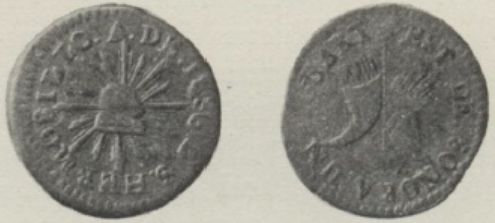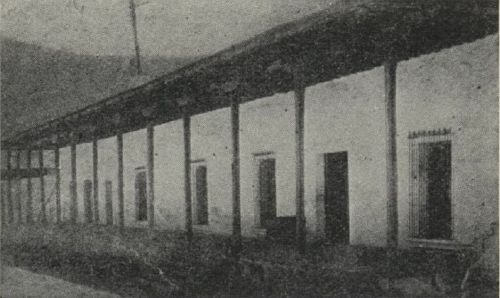The Alamos mint
by Alberto Francisco Pradeau
Alberto Francisco Pradeau, The Mexican Mints of Alamos and Hermosillo, NNM, No 63, American Numismatic Society, New York, 1934
Shortly after Mexico obtained its independence from Spain, when Sonora was still a part of the Province of Nueva Viscaya, a movement was started to have a mint in Alamos. Espinoza de los Monteros, in his project of separation presented 29 February 1823, has embodied the plan of erecting and operating a mint in Alamos. In 1828, Leonardo Santoyo arrived in Alamos with a concession or grant, obtained from the Federal Government, permitting him to coin copper coins of "una cuartilla" denomination - three and one-eighth cents.
The inhabitants in Alamos, however, refused to accept them .They were coined in very small quantities during the years 1828 and 1829. In 1832 we find that Mr. Santoyo had obtained a change in his grant and had gone to Hermosillo, where he coined a different type of “una cuartilla”. Hermosillo was then capital of the State of Sonora. The inscription on the obverse is EST. D. SONORA. UNA CUART.: on the reverse, A. de 1835 L. S. HERMOSILLO., which signifies "Año de 1835 Leonardo Santoyo Hermosillo."

The chief reason for the establishment of a mint in Alamos was the bonanza existent in the mining districts in and around the city. Owing to the isolation of this mining center which had no railroad until 1907, communication with other cities was possible only by stage-coach, saddle and pack animals. This means of conveyance was anything but safe, and while the convoys, carrying out the silver bars or bringing in the coined gold and silver, were properly escorted by armed guards, these were often outnumbered and massacred by the marauding Yaqui Indians or bandits constantly roving in search of plunder along the routes that led to Alamos.
Whether this mint was established by federal or state decree I have not been able to ascertain, but it is reasonable to assume that due to the French intervention existing from 1862 to 1867, and the inaccessibility of the region, the local authorities had much to do with its foundation. During this period, when the central government was constantly being changed from one locality to another, the states exercised the rights of independent governments, subject to approval of the federal government at such times as it was possible to get in touch with it.
According to official records the first coinage of this mint is given as 1868, but J. W. Bastow, writing in the American Journal of Numismatics, Volume XXXII, No. 1, of July 1897, page 17, gives the date of the first minting operations as 1864. I am wholly in accord with this, as I have in my collection an eight escudos piece dated 1864.
Orozco y Berra in his articles entitled "La Moneda en Mexico " published by the newspaper El Renacimiento in 1869, says in his second article: "Of the mints at Alamos and Hermosillo I have not been able to obtain any information through official channels or in any other manner." (Free translation.) Santiago Ramirez in his Noticia Historica de la Riqueza Minera de Mexico edited by the Government of Mexico in 1884, page 47, gives the beginning of coinage for the Alamos mint as of 1868. And one after another a number of writings on Mexican numismatics might be quoted in which everyone has used the official archives, which, as I have stated, are incorrect. The error was caused by the unsettled condition of the country due to the French intervention and the subsequent monarchy with Maximilian of Austria as Emperor, which lasted until 1867. It is more than probable that the records of the mint, which were supposed to be sent to the treasury department (Secretaria de Hacienda), were either lost in transit or destroyed.
The following statements of tremendous importance were taken from the book entitled Cuentas, gastos , acreedores y otros asuntos del tiempo de lo Intervencion Francesa y del Imperio written by Manuel Payno, and published in 1869 by order of the Constitutional Government of Mexico, pages 369-373. Free translation: "Not a single document is to be found in the national archives, that will throw light on the revenue-yielding industries of the country during the five years of French intervention in Mexico (1862-1867) excepting those of the mint at Mexico City, the records of which were kept quite accurately." The Minister of Finance (Secretario de Hacienda) in a circular letter addressed to all the mints of Mexico, asking for information about the amounts coined in each, during the years of 1857 to 1867, failed to bring in a report for the mint at Alamos, which is not even mentioned."
The very fact that coins of all denominations bearing the dates of 1864, 1865, 1866 and 1867 are to be found is conclusive proof that the Alamos mint was in operation from 1864 until 1895 at which time it was closed. The information concerning the opening date is corroborated by the statement of Mr. Bastow who obtained the information directly from the officers of the mint, while still in operation or shortly after its closing. This mint was turned into a federal assay office. The personnel of the mint was retained.
From Manuel Larraguibel, last mint master, and from Jorge LeBrun, son of the director of the mint during the years 1878 to 1883, and from Lauro B. Quiros, all old residents of Alamos, I learned that the Alamos mint was established with modern machinery propelled by steam power, but that hand presses were available and used for coining silver pieces of small denomination such as half and one real pieces, which from 1874 became five and ten cent pieces.
During most of its life, this mint was leased to private individuals or companies, and although the official records only show the leasing of this mint for the years of 1876 to 1880 inclusive, I have obtained from the above mentioned sources, statements that several companies leased this mint. The most prominent and the one which had it under contract the longest, was the English firm of Symon and Camacho. Several attempts to obtain a copy of this or any other contract have proven futile.
At the time of this writing, 12 February 1933, Manuel Larraguibel, the last mint master of Alamos , a grand old man 83 years of age, whom I had the privilege of knowing in Alamos some thirty years ago, and now a resident of Navojoa, Sonora, Mexico, writes to me and states that the mint in Alamos was established by Robert R. Symon, a British subject, and that in later years Robert R. Symon and Sebastian Camacho, formed a company under the name of Symon y Camacho and leased the mints of Alamos , Hermosillo , Culiacan and Durango .
On 1 March 1933, Manuel Larraguibel writes: "No coin could carry any other initials than those of the assayer" and that "Frequently when the dies for the new year were not available, those for the previous year were used."
In the "Anuario estadistico de la Republica Mexicana" for 1900, No. 8, and issued by Antonio Penafiel, I find the following information having reference to the mint at Hermosillo: "It seems that the opening of the mint at Hermosillo took place during the year 1852, but the first records of the amounts coined in this mint are dated 1861, in which year, this mint as well as that of Alamos, was leased to private individuals by the state government for a period of twenty years. The terms of the lease were that for the first ten years they could coin gold, silver and copper, without paying revenue to the government, having also the right of importing free of customs duty all the necessary materials for the operation of these mints, during a similar period. At the end of twenty years the title of the property was automatically to revert back to the state." (Free translation .)
Robert R. Symon, a British subject, received authority to establish the Hermosillo mint from the local government of Sonora. Later the same privilege was extended to the same individual for the establishment of the Alamos mint. Mr. Symon was ably assisted by Quintin Douglas, an American engineer, in the establishment and manufacture of the mint machinery. Manuel Larraguibel in letter of 30 March 1933, says: "In Alamos we used at the mint a set of large scales, so well constructed that when weighing 30 or 40 kilos (66 to 88 pounds ) it would register half a gram (8 grains ). These balances were made by Mr. Douglas."
Nothing is mentioned about the revenue that the lessors were to pay during the second ten years of operation, but two facts are definitely established; first that the mint at Alamos was founded in 1861, or at least contracted for, and operations must have begun almost immediately, as Manuel Larraguibel, the last mint master, in his letter of 7 February 1933, gives the year of 1862 as the date in which the first minting operations took place in Alamos; and secondly that the state and not the federal government was responsible for the establishment of these mints.
Date of closing of the mint
The Alamos mint was closed by order of the federal government on the last day of June of 1895. The machinery and dies were sent to the mint at Culiacan, State of Sinaloa. The building occupied by the mint continued as the federal assay office and the officers of the mint were retained until 1911, and discontinued after that.
The mint building

The building was located on the corner of "Calle de las Flores" and " Callejon de la Casa de Moneda." This street is only two blocks long. After the government had given up the federal assay office, the building was then purchased by Reynaldo Ramos, who by using more modern methods of assaying was able to obtain from the discarded tailings left in and around the old mint, a sufficient profit to repay him for his labors. There was also a period in which the whole lot occupied by the mint was excavated to a considerable depth in the belief that there might be a buried treasure, frequently found in the old houses of the city of Alamos. In the latter part of the month of December 1927, it rained in Alamos twenty-four inches in seventy-two hours, and this as well as the excavations that had preceded, caused the walls of the old edifice to crumble. So, today, 25 April, 1933, nothing remains. The useable wood and iron work were transported by Mr. Ramos to Navojoa and used in the construction of another building.
Assayers
The assayerslost updated were:
| Initials | Name | Began on | Left office on |
| PG | Pascual Gaxiola | 1862 | 1868 |
| DL or L | Domingo Larraguibel | 1866 | 1879 |
| AM | Antonio Moreno | 1872 | 1874 |
| ML or L | Miguel Larraguibel | 1876 | 1895 |
| ML | Manuel Larraguibel | 1878 | 1895 |
| JD | 1886 |
